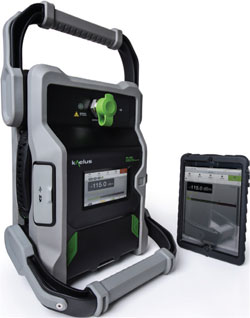
Beginning in 1996, Kaelus, formerly Summitek Instruments, has focused on providing test solutions for passive intermodulation (PIM). The Kaelus PIM test instruments defined a global standard in manufacturing and field test. As technology evolved toward remote radio heads and installation at the top of the tower, a new instrument architecture was required in the interest of personnel safety and test convenience.
Kaelus seized this opportunity to start with a blank sheet of paper and designed a solution built for purpose and that capitalized on all of the lessons learned in delivering more than 4000 PIM solutions for field use over the last five years. The resultant product, named the iPA, is uniquely suited for top-of-tower test as well as the more traditional applications of bottom of tower, rooftop and in-building. The obvious configuration change needed was to get smaller and lighter without sacrificing functionality. This meant higher levels of integration and creative mechanical layout.
Mechanical: Robust, Rugged, Weatherized
To withstand the abusive environment of field testing and hoisting units to the top of the tower, Kaelus focused on creating a toughened design. This is immediately evident upon first glance. The rubberized enclosure, the solid metal enclosure, the shatter resistant display and the strategically located dual handles assure long term survivability. It is so tough, you can even drive a vehicle over it.
There are no open portals to allow water penetration and no fans, as it is passively cooled. And, for good measure, the iPA includes four integrated lifting hooks eliminating the need for special packaging to get it to the top of the tower.
Safety and Convenience
Testing at the top of the tower is dangerous; particularly, if the test personnel are simultaneously trying to run the test equipment, observe the results and dynamically stress the RF path (flexing cables, tapping on connectors, tapping on the back of the antenna, etc.). To minimize the demand on personnel at the top of the tower, Kaelus integrated in a WiFi wireless access point and provides a WiFi-enabled tablet to accommodate remote control of the test by ground personnel. The remote control is a great convenience on rooftops where the PIM tester is connected back at the BTS and the test operator is remotely located near the antenna doing dynamic testing.
Test Efficiency
Test site certification can be a time-consuming and costly exercise that must be performed with precision and the results accurately communicated to the customer – most often the wireless network operator. The iPA requires no time-consuming calibration process prior to use and the operator interface is simplified to minimize opportunities for taking errant data or misinterpreting the results. The Kaelus industry leading reporting developed for the iQA has been incorporated and enhanced in the iPA.
Low Cost of Ownership
A key aspect of any test instrument is availability. The iPA builds on the experience of the industry stalwart of field PIM test equipment, the Kaelus iQA. The iPA’s robust mechanical design has already been described. Complementing this is the high reliability of the electronics as well as the focus on serviceability and low cost to repair.
RF Performance that Matters
The IEC specification for PIM test methods guides the design and the performance capability of nearly all PIM test solutions. Kaelus/Summitek has been active with the IEC committee on PIM for more than 15 years and helped define the test standard. Whereas the IEC recommends the test methods (two test tones at 20 watts per tone and measurement of IM3), for making a PIM measurement, it does not recommend what is an acceptable performance standard. This is left to the customer and the manufacturers.
Typical PIM specifications for manufacturing test are –107 dBm (–150 dBc) or better. For field testing, this is typically relaxed to –97 dBm (–140 dBc). This sets the performance requirements of the PIM tester. To keep measurement uncertainty to acceptable levels, the noise floor of the test instrument must be at least 10 dB better than the level being verified. It is important to note that the measurement noise floor is set by the thermal noise floor of the receiver, or the residual PIM (the PIM generated by the test setup), whichever is greater.
Implementing a high performance receiver subsystem with a noise floor better than –107 dBm is relatively straightforward. The iPA specification is significantly better than this at –128 dBm. The challenge is providing low residual PIM – not just at time of manufacture, but with a design that maintains this performance despite the abuse the unit will absorb as a field test tool. This is where the Kaelus PIM test solution excels. The Site Solutions division of Kaelus is known for designing, manufacturing and delivering high performance, low PIM. These same engineers provide the technology used in the PIM test equipment. The residual PIM is conservatively specified at –117 dBm (–160 dBc), but is typically better than –125 dBm (–168 dBc).
The Kaelus iPA family of battery powered PIM test equipment builds on the legacy and experience of more than 15 years addressing this measurement application. The iPA is a superior solution providing the very best in ruggedness, reliability, performance and utility.
Kaelus (a Smiths Company),
Centennial, CO
(303) 768-8080,
www.kaelus.com
